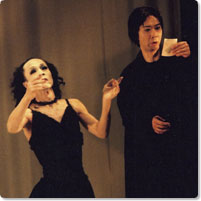KOMACHI
(April 2007 at Setagaya Public Theatre)
Data
:
Premiere: 2003
Length: Approx. 2hrs.
Acts/scenes: One act each
Cast:
Aoi: 4 (2 men, 2 women);
Komachi: 3 (2 men, 1 woman)
Takeshi Kawamura
Contemporary No Plays — Aoi/Komachi

Takeshi Kawamura
Born in 1959, native of Tokyo. In 1980 Kawamura formed the theater company “Daisan Erotica” primarily with the Theater Study Group of Meiji University as its parent body. After that he became a leader of the small-theater boom that occurred in Japan during the 1980s with impressive accomplishments. In 1985 he won the Kishida Drama Award for Eight Dogs of Shinjuku: Volume 1, Birth of Dogs . Among his representative works are Japan Wars, Hamletclone , AOI/KOMACHI , The Lost Babylon , Crocodile Tears and Rojo (On the Street) series and many more. He became an ACC Japan USA Arts Exchange Program grantee and began touring internationally (1990-97) with works starting from A Man Called Macbeth at the Theatre der Welt Essen, and performed drama readings in each country after AOI/KOMACHI was translated into French, English, German and Italian. He has continued to be active abroad, including things like a U.S. performance tour in 2007. In order to broaden his scope of activities, Kawamura establish the production company T Factory in 2002. For the Setagaya Public Theatre contemporary Noh Theater series he has written AOI/KOMACHI , Shuntokumaru , Shunkan-san and Ai no Kodo . He dissolved Daisan Erotica in 2010 on the occasion of its 30th anniversary. Since then, he has continued to work ambitiously as a playwright, while also writing novels and critiques and essays. Currently he is premiering plays by Pier Paolo Pasolini for the first time in Japan. Kawamura is a professor at the Kyoto University of Art and Design.

Aoi
Set in the present, this is a story about a charismatic hair designer.
Hikaru’s wife Aoi, who has been ill for the past half a year, has snuck out of the hospital and come to Hikaru’s salon asking him to give her a cut. More than the flesh-and-blood woman, Hikaru seems to love the hair that he cuts from them. His assistant in training, Toru, worries that Hikaru’s distorted love may be making Aoi’s illness worse.
Aoi reveals her jealous side by saying, “There is some of that woman’s hair mixed in with this cut hair you love so much.” The “woman” she refers to is Hikaru’s former lover, Rokujo. Much older than Hikaru, Rokujo fell in love with his talent and good looks when he was 22 and helped him climb to where he is today as a successful hair stylist.
Aoi leaves and Rokujo comes into the salon hoping to win him back, but Hikaru refuses, while admitting that he is grateful for helping him become successful.
Rokujo has an obsession with her relationship with Hikaru and reminds him that they are partners in crime by recreating the scene where they killed her former husband.
In response, Hikaru reveals to Rokujo that his relationship with Aoi is a special one because both he and Aoi were sexually abused by their fathers as children. Still, she mutters pathetically, “Can’t you come back to me?” As he continues to cut her hair, the stage lights go out.
As the lights come on, Hikaru is there on stage as if he has just regained consciousness. Was the previous scene an illusion?
Here, Rokujo appears as a lady of quiet nature and refinement gently expressing her joy that Hikaru is now living in happiness.
Here, Aoi, who was supposed to be back at the hospital, makes an appearance. Her head has been completely shaved of its hair by Toru. Having taken an interest in the young Toru, Rokujo leads him off. After watching them leave, Aoi asks Hikaru to cut her hair any way he pleases. Aoi asks him if he loves her. Making the actions of cutting her invisible hair, Hikaru says, “Yes. Of course I do. I will never let you go…. How beautiful it is …this hair.”
Curtain falls.
Komachi
It is autumn. In the distance there are sounds of war.
In an old theater in a run-down corner of a town, a film director who hasn’t made a film in eight years encounters a little-known masterpiece movie titled
A New Country
, starring the legendary actress named Komachi. It turns out that this is in fact the theater of that actress Komachi, who retired suddenly so early in her career and is now a withered old woman.
Abducted by an old man who waits on Komachi and calls her “princess,” the director finds himself being handed a tattered old script by her. It is the scenario of a movie that Major General Fukakusa had intended to make with Komachi as the heroine before he went off to war, never to return. The Major General had loved Komachi and visited the movie studio countless times to see her, and she also had fallen in love with him, the old man tells the director. He also says that the director bears a striking resemblance to the Major General.
The director is soon being forced to film the scenario with Komachi as the heroine. The old woman strikes a pose, as if standing in front of the camera. The clapperboard snaps. And there, in front of the camera, instead of what should be the withered old form of that actress we see an enthralling figure. Now possessed by the spirit of the Major General Fukakusa, the director begins to speak as if in delirium about the eternity of the soul and as he talks on, Komachi uses strands of the film to strangle him to death.
*In the premiere performance of this play, the old actress Komachi has no spoken lines of her own, and the part is acted out entirely as a dance performance by the butoh dancer Akira Kasai.
Related Tags

